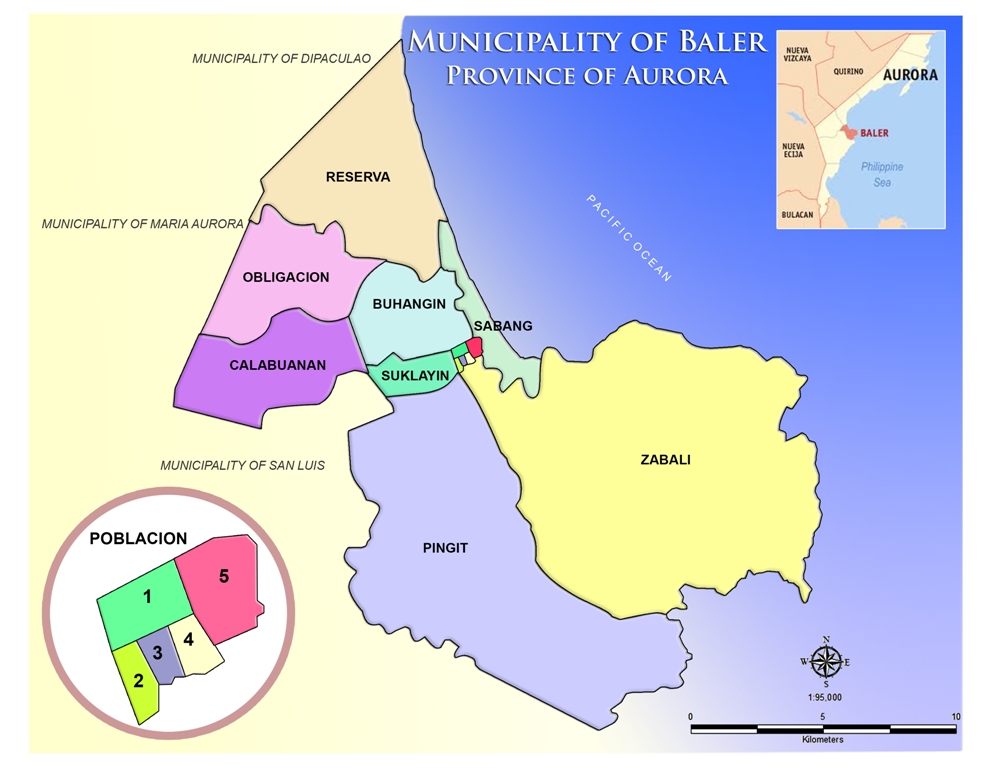
OFFICIAL NAME: Baler
CREATION: Became the capital town of Aurora Sub-Province on June 14, 1951 under Republic Act No. 648 and remained the seat of government of Aurora Province on Nov. 21, 1978 under Batas Pambansa Blg. 7.
LAND AREA : 9,255 hectares
POPULATION : 39,562 (2015)
Voting Population : 18,140 (as of January 2012)
No. of Precincts : Established: 154; Clustered: 63
NO. OF BARANGAYS: 13 barangays
- Brgy. 01 (Pob.)
- Brgy. 02 (Pob.)
- Brgy. 03 (Pob.)
- Brgy. 04 (Pob.)
- Brgy. 05 (Pob.)
- Buhangin
- Calabuanan
- Obligacion
- Pingit
- Reserva
- Sabang
- Suklayin
- Zabali
CLASSIFICATION : 3rd Class Municipality
TOWN FIESTA : August 19 – Birth Anniversary of President Manuel Luis Quezon
PATRONAL FIESTA : August 19 – Feast Day of San Luis Obispo de Tolosa
TOURIST SPOTS : • Museo de Baler • Quezon Memorial Park • Doña Aurora Memorial Shrine • San Luis Obispo Parish (Baler Catholic Church) • Aniao Islets • Cemento Beach and Cobra Reef • Dicasalarin Bay • Digisit • Dimadimalangat and Luksu-lukso Islets • Ermita Hill • Sabang Beach • Santo en Tierro • Lt. Commander James Gilmore Marker
PRODUCTS : coconut, rice, fish, citrus, processed food, sabutan, forest-based wood/non-wood products, livestock
BRIEF HISTORY: Baler, Casiguran and Infanta came to be known between 1570 and 1576 when Spanish conquistador Juan de Salcedo explored Luzon. Fray Esteban Ortiz , a Franciscan missionary arrived in Luzon in 1578, while Fray Blas Palomino who led 6 other missionaries came to Baler, Casiguran and Palanan in 1609. Franciscan Friar Juan Francisco de San Antonio who was in charge of Baler from 1611-1616 led the building of the first church of Baler. On December 26-27, 1735 a great storm came and huge wave of water, “Tromba Marina”, swept to the sea the old settlement of Baler. Survivors belonging to the families of the Angara, Bihasa, Bitong, Carrasco, Lumasac, and Poblete swam into safe plateau of Ermita Hill. Then a new community sprung into what is now the Poblacion of Baler and left ”Kinagunasan”, the place of devastation. “Baler” is said to have rooted from the word “Vale”, a name of an old woman; Dumagat word “balid” meaning “to return”; name of Lakan Balid, a nobleman; and “balod,” a mountain dove (paloma montes) based on “Vocabulario de la Lengua Tagala” by Tomas Pinpin in 1613 and by Juan de Noceda y Pedro de Sanlucar in 1754. The historic “Siege of Baler” (1898-1899), famed in movie Baler, inspired the signing of Republic Act No. 9187 on February 5, 2003 by then President Gloria Macapagal-Arroyo declaring June 30 of the year as Philippine-Spanish Friendship Day. In November 1901, Governor Cornelius Gardener annexed the towns of Baler and Casiguran to the province of Tayabas. In February 1902, Governor Harry H.Bandholtz caused a ten-man council manages the affairs of Baler and Casiguran until 1910. In January 1910, Benito Angara became the first elected mayor of Baler. On June 14, 1951, Baler became the capital town of the Subprovince of Aurora when President Elpidio R. Quirino signed RA No. 648. On November 21, 1978 it remained the seat of government of the new Province of Aurora by virtue of Batas Pambansa Blg. 7 signed by President Ferdinand Marcos.
